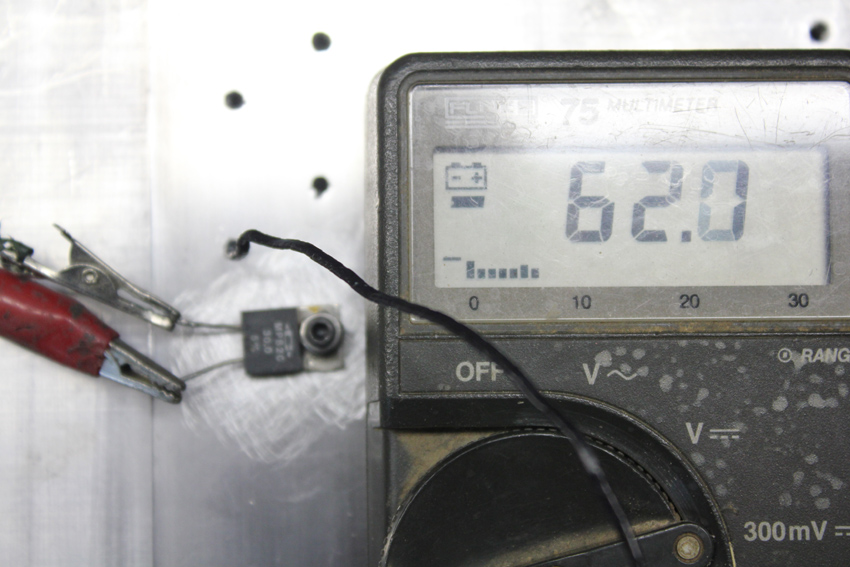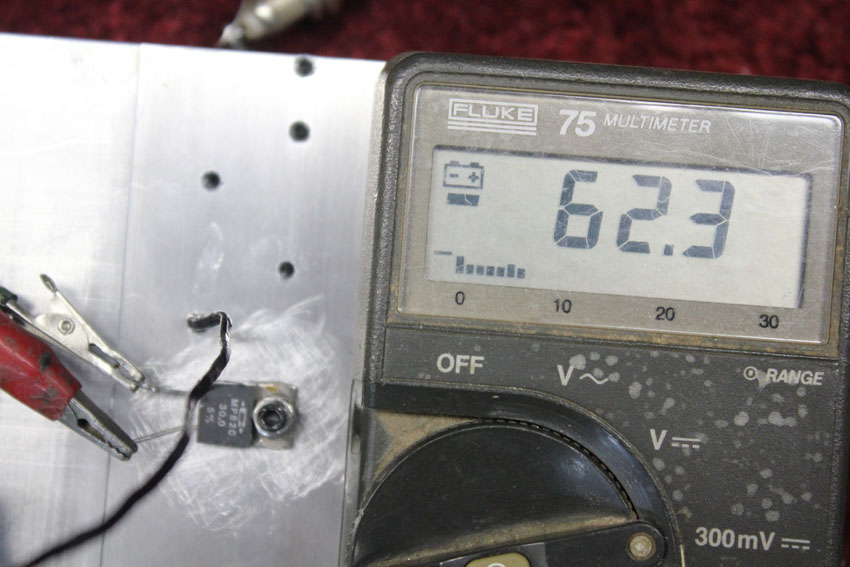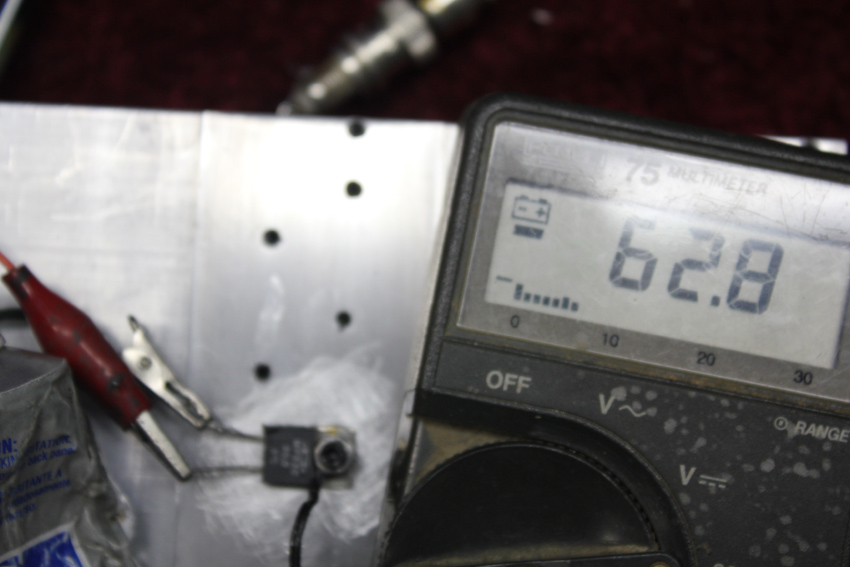Dielectric Grease vs Conductive Grease
[ Home ]
Use of greases in connection protection seems to be a controversial topic.
Some claim dielectric grease is conductive or abrasive, containing
silica that increases wear. (It doesn’t contain silica).
The most frequent Internet complaint is that dielectric grease
insulates connections, making connections less conductive. Some call pure
silicone grease an “insulating grease”. The general basis for
this claim is in the word “dielectric” used in the name. The word
dielectric is assumed to mean the connection will have future problems
because “dielectrics” are insulators. Generally, authors predict greases with powdered
metal (in slang “conductive greases”) will improve or maintain connection
quality over time while dielectric greases will isolate connections because
“that is what dielectrics do”.
History
My first experience with silicone grease was in the 1960’s as a lubricant in
record turntables. It was also commonly used as a lubricant and protectant on turret-type
television tuners, where channel coil packs or “strips” were mounted in a rotary
turret. Rotating the turret moved different channel strips over stationary
contacts to select each channel, and the clear silicon grease (which replaced a
green or red petroleum grease) lubed the contacts
and kept air off the plated surfaces. Later, RCA, Motorola, and Magnavox, facing
field failures from bad electrical contact connections in new modular
televisions recommended pure silicon
grease as a contact protectant. They sent kits that included pure silicone to be
directly applied to module contacts. This 100% pure silicone dielectric grease
reduced connection issues between circuit modules, pins, and sockets. Hundreds of thousands of TV sets with hundreds of
connections in each TV were living with silicone grease on signal
and high voltage connections. Silicone
grease also lubricated frequently-switched gold or silver plated contacts,
and low voltage signal level module contacts. Silicone grease was also used
directly on high voltage CRT anode
connectors to prevent or reduce corona.
My second experience was in the CATV industry. As a systems engineer, I was
drawn into signal loss, radiation, and ingress problems in CATV/MATV systems. Problems
centered around dry connections that corroded, and around aluminum trunk cable
shield connections protected by Noalox, a grease people often call “conductive”.
All of these problems were eliminated by “non-conductive” silicone grease. The initial
grease and sealer I brought into the systems was a white Teflon-silicone grease
from a company in Elyria, Ohio. While that grease solved problems, it was
expensive to apply to tens of thousands of fittings. It also was unsightly,
service personal would leave white fingerprints everywhere. After consulting
with several grease manufacturers, I switched to a GE 100% pure silicone
dielectric grease in all CATV fittings. We used that grease without incident for many years
in hundreds of thousands of connectors, completely
flooding F connectors that were directly exposed to snow or rain.
I continue to use silicone dielectric grease today. I use it as a lubricant
on coaxial connector O-rings and threads. I use it to lube stainless bolts and
nuts, to prevent galling. I use it for plug-in connections, in particular in my
automotive hobby. I also use silicone dielectric grease for battery terminal
connection preservation, coating it directly on the battery post. I use it in
liberal amounts on ground connections, to inhibit corrosion on stainless-to-zinc
(galvanized), lead-to-lead, stainless-to-copper, and stainless-to-aluminum
electrical connections.
I have never found a problem with silicone dielectric compound increasing
resistance or increasing wear. We use it in new equipment production to lubricate
and preserve contact plating in very low current meter switches. It has never caused shorts across insulation, I use it on spark plug HV
boots on race engines and in high voltage connectors. I also use directly on
contacts in my EFI system, including low voltage sensors.
Silicone vs. Petroleum Grease
Petroleum grease (Vaseline) was recommended (and was apparently used) on low
power antenna installations years ago. While people report using it without
problems, I never use it in my installations. The primary shortfall of
Vaseline is the very low melting point. Most brands or types liquefy at around
100 degrees F, just above human body temperature. While this may be a medical
benefit when coating human skin, it is a serious problem with connector
applications. Any heat will cause Vaseline to run and eventually dry out over time.
A second petroleum jelly issue is Vaseline’s release of flammable vapor,
even at low temperatures. A cotton ball soaked in Vaseline will burn a very long
time, and actually makes a good fire starter. Since connectors are often near
insulation or other things that can act like wicks, petroleum jelly is not the
best thing. This is especially true since grease migrates in warm
temperatures.
Typical Applications for Greases
Heat sinks
Internet forums thrive on myths. Forums often claim dielectric
grease thermally insulates connections. Forums also claim dielectric grease
electrically insulates connections, such as in connectors and on battery posts.
Neither is true.
Here is a test using a 35-watt dissipation resistor. The resistor is mounted
to the heatsink with a stack of
Belleville washers. These washers
are conical spring washers. They maintain a
constant pressure when partially collapsed. Proper Belleville washer
implementation ensures compression or pressure
against the heatsink is essentially the same between tests. The Belleville eliminats cap
screw torque as a factor in results.

Here is measured data of a few sample greases with 30 watts heat dissipation:
| Type | Sink F | Device F | Delta degrees | Percent (aprox) |
| Bare lightly scuffed |
62.0 | 63.9 | 1.9 | 3.1% |
| Heat sink compound thick |
55.9 | 57.6 | 1.7 | 3.0% |
| Bare polished |
61.6 | 63.0 | 1.4 | 2.3% |
| Vaseline | 62.5 | 63.1 | 0.6 | 1.0% |
| Dielectric grease | 62.3 | 62.8 | 0.5 | 0.8% |
| Heat sink compound thinly applied |
56.2 | 56.6 | 0.4 | 0.7% |
Best result is at bottom. All greases were tested under “scuffed” conditions
by roughing the heatsink with ~300 grit paper.
Using too much dense grease, like thick heatsink compound, greatly increased
thermal resistance. This occurred because compression pressure was not enough to
force excess grease out of the area between the heatsink and the resistor tab.
When the layer was thinned to a light “wipe” of grease, thermal resistance fell
off significantly.
There is essentially no difference between Permatex Dielectric Tune Up Grease
and a special heatsink compound used on high-power transistors. Even Vaseline,
at 1%, is better than bare metal-on-metal.


Connectors
In radio frequency low power installations, in particular at low frequencies
and/or when the connector has very little air gap, completely flooding the
connector is perfectly acceptable. Flooding a connector is not acceptable at
high power, because most greases will carburize when subjected to an arc.
Greases also change the dielectric constant, lowering the dielectric constant in
the connector. This may create an impedance bump at very high frequencies, the
problem’s effect on the system being entirely dependent on the length of the
bump in electrical degrees and the amount of the bump. (Not all things that show
on a TDR
meaningfuly alter performance, but they do indicate a potential problem.)
In regular low voltage multiple-pin circuit connectors, such as
automotive applications, flooding with a
proper insulating grease of low-viscosity dielectric grease is perfectly
acceptable unless a manufacturer recommends against it. The grease should have
good stability and not contain metals in any form, and be specifically designed
for use as a dielectric grease. This generally is a silicone dielectric grease,
although some Teflon based greases are acceptable.
In single low-voltage terminals or connections, such as metal-to-metal
joints, grounds, or battery posts, almost any pure grease of light viscosity
will be acceptable. Caution should be used with greases containing metallic
powders to be sure any metal is compatible with the embedded grease metal.
Connection enhancement from embedded metal powder is very minor, if it exists at
all, and unless you match the grease to the connector material, risk of
interaction with base metals might increase.
In single high voltage connections, such as spark plug boots or other high
voltage connectors (x-ray, neon sign, or HV power lines), only pure dielectric
silicone greases should be used. Generally a light coating or wipe is all that
is required. Dielectric grease will actually increase voltage breakdown across
insulators, especially in the presence of moisture. Never use or allow a
metalized grease around HV connections.
The important physical characteristic is that any grease must have low enough
viscosity to push out of the way at contact points, be water or liquid
resistant, and be stable enough to remain in place as a protectant against
moisture and air for a long time. It will not do any good to apply a grease that
does not do required functions of excluding air and moisture, and lubricating
the interface to prevent galling or
fretting, for extended
periods of time.
Contrary toInternet rumors, advertisements, and articles low viscosity silicone dielectric grease
will NOT insulate pressure connections. Silicone dielectric grease
will prolong connection life as well as, and have just as good conduction
performance, as a properly selected metallic powder grease (conductive grease).
On the other hand, and improperly selected “conductive” grease can actually
cause connection problems.
Switches, Movable Contacts, and Relays
Unless you are absolutely sure what you are doing is OK, do only what a
switch or relay manufacturer suggests. There are some cases where very high
current contacts can be lubricated, or should be lubricated, to prolong or
extend life. There are many cases where lubricating contacts accelerates
failure.
As a general rule, low-viscosity greases can be directly applied to
low-voltage contacts. Low-voltage generally would include consideration of
opening or closing transient voltages, such as opening arcs from inductance
back-pulse.
Contact arcs have the ability to alter composition of greases. Silicone
greases can be converted by arcs to silicone carbide, which is highly abrasive.
For this reason, silicone grease should be avoided when contacts are “hot
switched” and have any chance of arcing.
Insulating and Conducting Grease
Both dielectric grease and “conductive” greases (anti-seize) are insulators.
The primary difference between dielectric greases and “conductive” greases is
that “conductive” greases and anti-seize greases include some amount
of finely-powdered
metal. The finely powdered metal is suspended by insulating grease, so it does
not conduct. The suspended metal powder does lower the voltage breakdown of any
arc paths through the grease.
Articles claim sparkplug threads are insulated by anti-seize, causing
sparkplug or ignition fault indications. This is obviously wrong for several
reasons, most predominantly because of voltages and currents involved. I suspect
the real problem was anti-seize contaminated the plug insulator. Tests here show
anti-seize and other metal-loaded “conductive greases” reduce high voltage
breakdown voltages of air paths or surface path resistances of insulators
significantly. Fingerprints on, or worse yet slathering of “conductive grease”
on insulators or insulation, seriously degrades high voltage hold off.
“Conductive” grease could trigger an ignition misfire warning code if a single
fingerprint bridges the spark plug insulator.
Other articles tell people to use conductive grease on connections, such as
between battery terminals and an automotive battery. Tests show this claim is
completely wishful thinking, and the type of grease has virtually no impact on
terminal-to-post voltage drop.
Again, we have a direct contradiction. People reporting anti-seize insulates
a spark plug from the cylinder head are calling people liars who report
conductive grease
enhances a battery terminal connection, or vice versa. Generally, when two groups provide
exactly opposite claims, at least one notion or claim is wrong. In
this case, both are wrong. Neither group appears to understand resistance,
current, and voltage.
All of these dielectric greases, and virtually all from other manufacturers,
both improve insulation and preserve electrical connections. They do this by
sealing contaminants, moisture, and air out of connections. They also seal
insulators, keeping moisture and contaminants out of insulation. They are as
effective at preserving connections as “conductive” grease, and will not harm
insulation.
Historic Applications of Silicone Dielectric Grease
Silicone Dielectric Grease (and lubricant) is a low viscosity grease. The
normal temperature range is from around -40F up to +500F degrees. Silicone
Dielectric Grease is far superior to petroleum jelly or Vaseline for preserving
connections.
Silicone grease has been around for a long time. It was used in the following
applications:
| Application | Prevention | Junction Materials |
| Early turret and rotary switch television tuners |
tarnish, wear, friction | gold and silver flashed contacts |
| Low power potentiometers or volume controls |
wear, electrical noise, friction |
carbon and brass |
| Low voltage or non-arcing switches |
tarnish, wear, friction | gold or silver flash or plating |
| Connector pins | tarnish, wear, fretting | cadmium, zinc, silver, or gold surfaces |
| Bolted connections | tarnish, corrosion, friction |
lead, copper, aluminum, stainless, zinc |
| Grommets and O-rings | wear, tear, air and water leaks |
rubber or silicone based sealing rings |
| Thermal conductivity aide |
fills air voids and seals out moisture |
aluminum, copper, beryllium, mica, silicone |
One incorrect logic is the “dielectric” in “dielectric grease” means the
grease should only be used to insulate. All greases work by the low viscosity
allowing the grease to completely push out of areas with metal-to-metal contact.
Dielectric grease is just better at holding off high voltages over long paths.
Conductive Grease
Conductive greases and anti-seize compounds have a suspended base metal
powder. The suspended metal powder is a fraction of the area occupied by
insulating grease, and so the grease still insulates the connection. The grease
does not conduct.
The working theory of “conductive” grease is when pressure is applied, the
grease squeezes out of the way. This leaves a fine metal
powder that theoretically pierces oxides or fills voids. Using aluminum and copper blocks with various
surface conditions, I’ve never been able to actually verify connection improvement from
specialized conductive greases. In my tests, it appeared the grease
simply carried most of the suspended powder away. Any remaining powder has never been
enough to reliably reduce voltage drop across clamped connections. The change in
voltage drop has always been indefinable, even with careful repeats of clamping
pressure. I’d appreciate anyone having useful data sending me a copy.
The suspended powder creates a problem that does not exist with dielectric
grease. The suspended metal must be fully compatible with the metals being
clamped. This means conductive grease is application specific. If the metals
being clamped are incompatible with the grease’s suspended metal powder, the
connection will eventually fail. This is what happened in our CATV system
connectors. The connections were a mix of copper, aluminum, and steel. The cable
shields were aluminum, the trunk center conductors cables were copper clad
aluminum. Drop cables were aluminum shields and connectors, with copper clad
steel centers. Our records showed a much higher incidence of corrosion failure
using conductive grease. Corrosion failure rate dropped significantly, almost to
zero, when we switched to pure dielectric grease.
In bolted or clamped
connections, I have no opinion if conductive greases help or are necessary.
I feel like they help, but I’m not sure if that is true. I use Noalox on clamped aluminum slip joints in antennas because it is generally less
expensive than silicone dielectric greases and it appears to last longer. I
NEVER use conductive greases on
push fit electrical connectors, or if I am unsure of metal to grease compatibility.
Conductive greases should specifically match materials being clamped.
Conductive greases should never be used in low pressure electrical connectors,
or in connectors with multiple terminals. Conductive greases should
only be used in connections that are well-isolated from
connections with differing voltages, and never in high voltage connections. They
never belong in RF or signal connectors, unless they are bolted connections and
the material compatible grease does not bridge insulation.